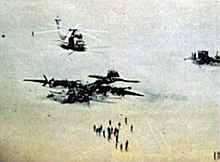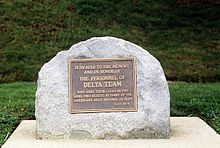Operation Eagle Claw
The Operation Eagle Claw ( German "Company eagle claw" ), also operating Evening Light ( German "Company evening light" ) called, was a military operation of the United States .
The operation took place on the order of US President Jimmy Carter on April 24, 1980 with the aim of freeing 53 hostages held in the US Embassy and the State Department of Iran in the course of the hostage-taking of Tehran . It was a failure. Apart from Vice Consul Richard Queen, who was released on July 11, 1980 for "humanitarian reasons" because of his poor health after Ayatollah Khomeini had ordered this the day before, the remaining 52 hostages did not follow until 444 days after their abduction in January 1981 Negotiations between the USA and Iran free again.
prehistory
On November 4, 1979 at 11:30 am, around 400 Iranian students from the Daneshjuyane Khate Emam group occupied the US embassy in Tehran. The embassy’s 90 residents were arrested and the 66 Americans were declared prisoners in order to force the extradition of the former Shah Mohammad Reza Pahlavi , who was being treated in a clinic in New York City . The US refused extradition.
Six Americans escaped and fled to the Canadian embassy; they could leave with forged passports. 13 hostages - women and African American - were released on November 19. After that, 53 people remained trapped. Economic sanctions, diplomatic reprisals and UN Security Council resolutions remained fruitless.
In March 1980, the military planning and exercises for a limited intervention had progressed so far that the military leadership could present the then US President Jimmy Carter on March 22nd at Camp David military options. Carter's security advisor Zbigniew Brzeziński had coordinated with the military to develop a plan for the violent release of the hostages. On April 11th, Carter decided to launch the clandestine military operation, codenamed Eagle Claw . The earliest possible date was set on April 24th. On April 16, the military leadership confirmed that Eagle Claw could call. However, Carter banned some planned elements of the operation, such as: B. accompanying air strikes in order to minimize Iranian losses and to avoid an Iranian declaration of war. Carter also wanted to be kept informed of everything as the operation progressed.
planning
Operational goals
The strategic and operational objectives of Operation Eagle Claw were defined as follows:
- Strategic goal: rescue all American hostages in Iran
- Operational goals:
- Secure Desert One refueling and transfer base
- Secure Desert Two transfer base
- Secure figbar and wadi hiding spots
- Storm the US embassy and secure fifty hostages
- Storm the Foreign Ministry and secure three hostages
- Secure Manzariyeh Airfield
- Withdrawal of all forces from Tehran and Manzarieh
plan
The operation was planned as a complex action over two nights. Eight RH-53D Sea Stallion helicopters from the aircraft carrier USS Nimitz (CVN 68) and three Lockheed C-130 Hercules transport aircraft with Delta Force units were scheduled to fly to the Desert One meeting point on the first night . After the troops were positioned, three more Hercules planes were supposed to arrive to refuel the helicopters. After refueling the helicopters, they should pick up the ground troops and fly to Desert Two near Tehran. There they were to be received by two agents who were already in the country and taken to their hiding place, a wadi , where they were to wait until the next night. The helicopters were to wait not far from there, shielded by a hill, for their deployment the following night.
On the second night, the six C-130 Hercules planes were to fly with US Army Rangers to Manzariyeh Airport 50 km south of Tehran and capture it. Under cover of darkness, the hostages should then be freed by the Delta Force units and taken to a nearby football stadium. There they should be picked up by the helicopters and taken to the airport. With Lockheed C-141 Starlifter transport aircraft , the hostages were then to be removed under the protection of combat aircraft . The eight helicopters were supposed to be destroyed before the troops were evacuated.
According to the Iranian magazine Modjahed 6/1980, the preparations within Iran included the leave of absence of the air force personnel from Mashhad as well as the shutdown of the Babolsar radar station a few days earlier. On the night of the planned liberation action , the floodlights of Tehran's Amdjadijeh Stadium , today's Shahid Shiroudi Stadium , were switched on all night.
The US side had previously held detailed talks with a South African diplomat who had been asked for advice because of his good knowledge of the area (five years of Tehran). He had gained the impression that the hostages should only be freed and transported back by car, since the helicopters would not land near the embassy and, at best, in the nearby sports stadium was conceivable in several extended phases.
course
The mission was problematic from the start. Due to an engine failure, one of the helicopters failed as soon as it reached the coast and had to return to the aircraft carrier Nimitz . The remaining Sea Stallions reached Desert One late because they were slowed down by a habub , a weak sandstorm. In order to fly under the Iranian radar, the pilots were instructed not to fly above 200 feet, which caused the helicopter fleet to suffer from the sandstorm. Before the rest of the helicopters arrived, the first C-130 Hercules transport plane landed with ground troops. The ground forces took positions and stopped an Iranian bus with 45 occupants and detained them. Then a tanker approached , refused to stop, was then shot at and exploded despite an order not to fire. The driver died. There were plans to fly the occupants of the bus hostage out of the country and bring them back into the country when the mission was over. In the meantime, the remaining transport aircraft arrived and unloaded the ground forces. When the Navy helicopters landed, another helicopter failed after warning lights indicated its power transmission was no longer working. This meant that the rescue operation for all hostages could no longer be carried out.
Thereupon the commander of the ground forces, Charles Beckwith , in agreement with the president, reluctantly ordered the withdrawal. The six remaining helicopters still had to be refueled for the return flight. 600 kilometers southeast of Tehran over a desert area, a hovering helicopter collided with one of the Hercules planes due to poor visibility through the darkness and blown sand. The following explosion destroyed both aircraft and killed eight soldiers. In the chaotic retreat that followed, the five remaining Sea Stallion helicopters were left intact. They also contained documents containing the names of CIA agents in Iran.
consequences
On the military level, the failure of the operation led to the creation of the 160th SOAR (Nightstalkers) . a. Pilots are trained to carry out difficult missions at any time and in any weather. The creation of the United States Special Operations Command was also a result of the failed action to ensure better interaction between the special forces of the armed forces in the future.
The development contract for the vertical take -off aircraft MV-22 Osprey was also approved following the failure of Operation Eagle Claw, as it avoided the problems caused by the interaction of C-130 transport aircraft and Sea Stallion helicopters and has a much greater range than the helicopters.
The Iranian leadership cannibalized the failed action in their favor; u. a. some of the bodies of the US soldiers were presented in front of television cameras with the participation of Sadegh Chalkhali . The US Secretary of State Cyrus Vance , who had opposed the military action to free the hostages, resigned.
literature
- Eric L. Haney: Delta Force. In action against terror . Goldmann Verlag, Munich 2003, ISBN 3-442-15215-1 .
- Daniel P. Bolger: Americans at War 1975-1986. An Era of Violent Peace . Presidio Press, Novato, California 1988, ISBN 0-89141-303-0 ( limited preview in Google Book Search).
- Kaj-Gunnar Sievert: Command Company. Special units deployed around the world. Mittler, Hamburg et al. 2004, ISBN 3-8132-0822-2 .
Web links
- Klaus Wiegrefe : Fight for "Operation Eagle Claw" . In: one day . March 27, 2008.
- Airforce historical support division: Operation Eagle Claw. Online text, October 16, 2012.
- A mission of hope turned tragic. A case of what could've been. ( Memento from June 13, 2008 in the Internet Archive ) (Eyewitness report from the US Air Force Airman magazine , web edition April 2001; Eng.)
- Operation Eagle Claw (detailed mission description with pictures on a helicopter history page)
Individual evidence
- ↑ captured in the State Department and set the chargé Laingen, Security Aide Howland and Senior Political Officer were Tomseth, see. List of all hostages and soldiers who died in Operation Eagle Claw, in the online listing in the Jimmy Carter Library [1]
- ^ Paul Lewis: Richard I. Queen, 51, Hostage Freed Early by Iranians in '80. In: NYTimes.com. August 21, 2002, accessed August 21, 2015 (obituary for Richard I. Queen (1951–2002)).
- ↑ List of all hostages and soldiers who died in Operation Eagle Claw, at jimmycarterlibrary.gov ( Memento from September 5, 2015 in the Internet Archive )
- ^ A b Daniel P. Bolger: Americans at War 1975–1986. An Era of Violent Peace . Presidio Press, 1988, pp. 138-139 .
- ↑ Ebert, Fürtig, Müller: The Islamic Republic of Iran . S. 218 .
- ↑ Tim Geiger, Amit Das Gupta, Tim Szatkowski: Files on the Foreign Policy of the Federal Republic of Germany 1980 Vol. I: January 1 to June 30, 1980. R. Oldenbourg Verlag, Munich 2011, p. 721.
- ↑ Christopher de Bellaigue: In the rose garden of the martyrs. A portrait of Iran. From the English by Sigrid Langhaeuser, Verlag CH Beck, Munich 2006 (English original edition: London 2004), p. 101
- ↑ Christopher de Bellaigue, p. 101




